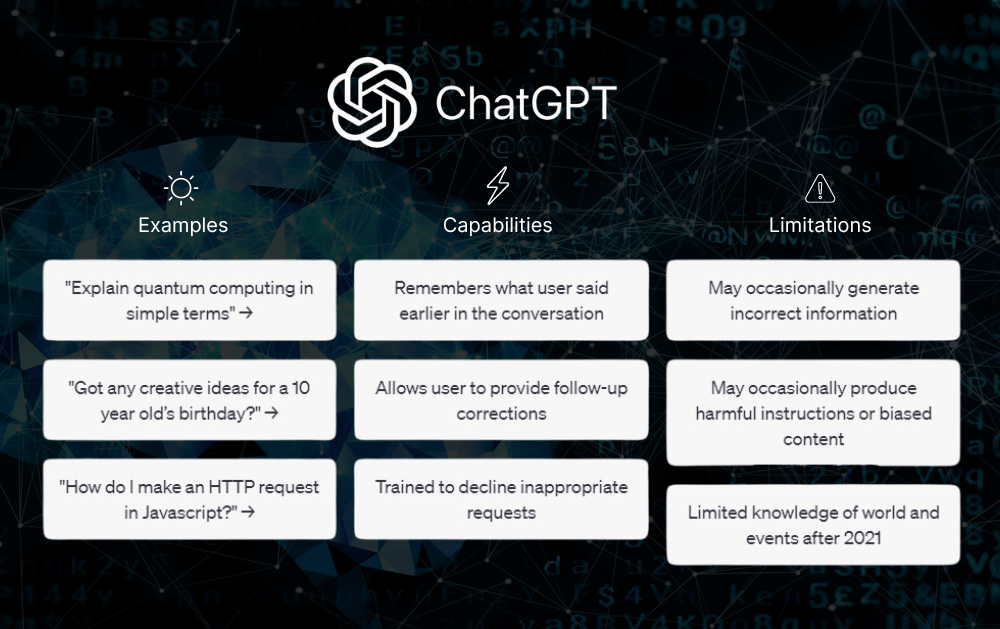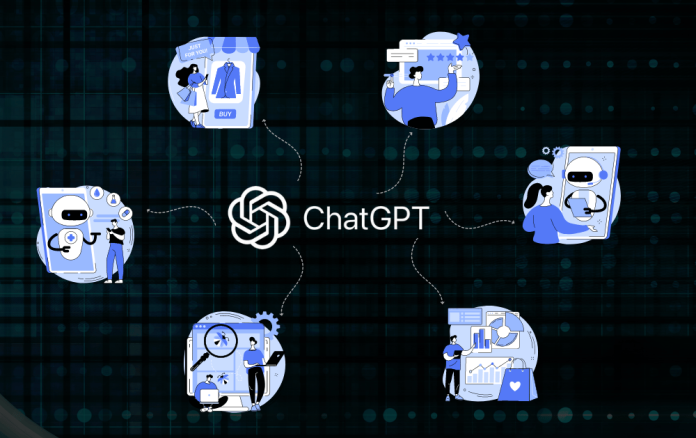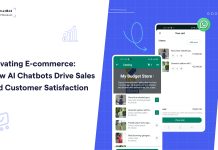Today, all business categories in the market must have a website. And artificial intelligence is altering online design and development. According to Statista, revenue generated by AI is estimated to reach $126 billion by 2025.
With the incorporation of Artificial Intelligence (AI), the discipline of web design has undergone a transformational transition. AI has emerged as a strong tool for web designers, streamlining the process, improving user experience, and allowing them to create more personalised and dynamic websites. ChatGPT, powered by OpenAI’s GPT (Generative Pre-trained Transformer), stands out among cutting-edge AI models for its capacity to read and generate human-like prose. Before we move on to how ChatGPT, is transforming each stage of the web design process, let’s understand ChatGPT & its capabilities.

ChatGPT and Its Capabilities
ChatGPT is a GPT (Generative Pre-trained Transformer) model version powered by deep learning methods and trained on a vast dataset of different language patterns and structures. It is intended to interpret and generate human-like prose, making it a perfect tool for conversational interfaces, chatbots, and content development. ChatGPT can be fine-tuned and customised to meet unique site design needs. It can offer contextually appropriate and innovative suggestions after being trained on design-related data.
This article delves into the enormous potential of ChatGPT in web design, demonstrating how using AI may improve user experience, personalise information, optimise layouts, and open creative possibilities for designers.
Benefits of Integrating AI into Web Design
AI integration in web design offers a host of advantages that can revolutionise the user experience.
- Personalization: AI enables websites to offer personalized experiences to users based on their preferences, behaviour, and interactions. Customised content and recommendations enhance user engagement and satisfaction.
- Enhanced User Experience: AI-driven interfaces, such as chatbots and virtual assistants, provide real-time support and guidance to users, improving the overall user experience and making navigation more intuitive.
- Efficient Content Creation: AI can automate content creation by generating high-quality and relevant content, saving time and effort for content creators while ensuring a consistent flow of fresh content.
- Rapid Design Iteration: AI tools can quickly generate design alternatives, enabling designers to explore various options and iterate more efficiently, leading to better design decisions.
- Data-Driven Insights: AI can analyze user data and behaviour, providing designers with valuable insights to make data-driven decisions, optimize designs, and improve website performance.
- Streamlined Testing and Bug Detection: AI-powered testing tools can automate the testing process, identifying bugs and errors more efficiently, leading to a higher quality website with fewer issues.
- Speed and Performance Optimization: AI algorithms can optimize website loading times, improving user experience and search engine rankings.
- Enhanced Search and Navigation: AI-powered search functionalities understand user queries better, delivering more accurate results, and improving website navigation.
- Voice and Visual Interfaces: AI enables the integration of voice assistants and visual recognition technologies, making website navigation more intuitive and accessible.
How AI Is Transforming the Web Design Process?
1. AI-Powered Research & Inspiration
Web designers have always conducted considerable research to gain insights into the target audience, competition, and industry trends. By creating relevant material based on individual inquiries, ChatGPT can considerably hasten this stage. Designers may quickly get significant insights into their design decisions by giving ChatGPT questions regarding audience preferences, design styles, or competitive analyses.
Example: Designers working on a fashion e-commerce website can utilise ChatGPT to generate information relevant to trending fashion styles, popular colour combinations, and client preferences, giving them ideas for new designs.
2. AI-Driven Wireframing & Prototyping
Wireframing and prototyping are important processes in web design because they allow you to visualise the website layout and user interactions. AI-powered tools can help designers create wireframes based on specifications and even suggest potential interactions for a more intuitive user experience.
For example, designers can utilise ChatGPT to automatically produce wireframes with proposed layouts and interactive features by inputting the important elements and functionalities needed, making the prototyping process more efficient.
3. Personalization and User Experience
Creating a personalized user experience is essential for modern websites. AI, particularly ChatGPT, can analyze user behaviour, preferences, and historical data to deliver tailored content and recommendations to each visitor. This personalized touch enhances user engagement and encourages them to spend more time on the website.
Example: An online news platform integrated ChatGPT to analyze user reading patterns and preferences. Based on this analysis, ChatGPT suggests articles, videos, and related content personalized for each user, resulting in higher user retention and increased page views.
4. AI-Powered Content Creation
Content is the backbone of any website, and AI-powered content generation tools can be invaluable for web designers. ChatGPT can assist in creating blog posts, product descriptions, FAQs, and other textual content, saving time and effort for designers and content creators.
Example: A travel agency uses ChatGPT to automatically generate engaging travel guides, destination descriptions, and travel tips based on user queries and destination-specific information.
5. ChatGPT-Powered Interactive Elements
Chatbots and virtual assistants have become popular interactive elements on websites. ChatGPT’s natural language understanding allows designers to create AI-powered chatbots that can engage users in real-time conversations, answer queries, and offer personalized assistance.
Example: A customer support chatbot integrated with ChatGPT can efficiently handle user inquiries, providing instant responses and guiding customers through the website, leading to improved customer satisfaction.
6. AI-Enhanced A/B Testing and Data Analysis
A/B testing is essential for optimizing website elements. AI can analyze A/B test results and user behaviour data to identify trends, patterns, and preferences, helping designers make data-driven decisions for further improvements.
Example: ChatGPT can analyze A/B test data and user feedback to recommend design variations that resonate better with the target audience, leading to higher conversion rates and improved website performance.
7. AI-Driven User Feedback and Sentiment Analysis
Collecting user feedback and understanding user sentiments are critical for enhancing user experience and making iterative improvements. AI can process user feedback and sentiment analysis at scale, providing valuable insights into user perceptions.
Example: ChatGPT can analyze user feedback from various sources like customer support chats, social media comments, and survey responses, allowing designers to address pain points and improve user satisfaction.
8. AI-Generated Dynamic Content Updates
Websites often require frequent updates like news articles, events, or product listings. AI-powered tools can automate content updates, keeping the website fresh and relevant without manual intervention.
Example: A company blog can integrate ChatGPT to automatically generate and publish blog posts on scheduled intervals, ensuring a consistent flow of content without manual effort.
9. Predictive Analytics for Design Trends
AI can analyze vast amounts of data and predict design trends, providing designers with insights into emerging styles, colour schemes, and visual elements, helping them stay ahead in the ever-evolving design landscape.
Example: By analyzing social media images, design publications, and user interactions, ChatGPT can predict upcoming design trends, enabling designers to incorporate them into their projects.
How Web Developers Can Effectively Use AI?
Developers must take help from AI to assist with a task, not depend on AI to complete it for them. One of the most crucial things to remember when dealing with AI-written code is that human interaction is always required. They are referred to as “assistants” since they must work alongside you rather than for you.
Consider how AI can assist users. Using artificial intelligence in web development entails more than just using coding assistance. Customer experience and support chatbots, for example, can be used to help people interact with websites and companies in new and more efficient ways.
To free up your time, delegate low-level tasks to AI. When applied effectively, AI can assist programmers in spending more time working on new and complicated projects.
Challenges and Considerations with AI Integration
- Concerns about data privacy and security: Collecting user data to train AI models necessitates paying close attention to privacy and security standards to protect user information.
- Balancing AI Automation and Human Creativity: While AI improves efficiency, designers must strike a balance between automated jobs and human creativity to maintain a distinct and authentic design identity.
- AI-Generated Content Management in SEO and Branding Initiatives: AI-generated content should be managed in conjunction with SEO and branding initiatives to ensure consistency and brand messaging.
- AI Limitations and Errors in Web Design: Designers should know AI’s limitations and check AI-generated material to minimise errors or misinterpretations.
Future of AI-Driven Web Design
AI models like ChatGPT will continue to grow, providing web designers with more advanced capabilities and deeper insights. AI-powered chatbots combined with voice assistants and visual interfaces will revolutionise user interactions and make websites more accessible. AI is projected to play a key role in automating complicated design chores, further personalising user experiences, and helping designers to create creative and engaging web designs.
Conclusion
To summarise, the use of AI, notably ChatGPT, has ushered in a new era of online design. Designers can now design more personalised, engaging, and efficient websites, revolutionising how people interact with the digital world. As the AI environment evolves, it is critical for web design company in Kolkata to embrace AI responsibly, guaranteeing openness, justice, and accountability in its application. Designers may define the future of user experiences and attain new heights in their creative activities by utilising the possibilities of ChatGPT in web design.
Author Bio –
 Khurshid Alam is the founder and director of Pixel Street. A top Web Design Agency In Kolkata. He has over 8 years of experience in the industry and has worked with some of the world’s leading brands including ITC, The Hindu Group, Glocal Healthcare, etc.
Khurshid Alam is the founder and director of Pixel Street. A top Web Design Agency In Kolkata. He has over 8 years of experience in the industry and has worked with some of the world’s leading brands including ITC, The Hindu Group, Glocal Healthcare, etc.




















![TamilMV Proxy List Top 30+ [Unblock TamilMV Sites] TamilMV Proxy Unblock](https://technewsgather.com/wp-content/uploads/2023/04/17825836_SL-121019-25870-14-1-100x70.jpg)